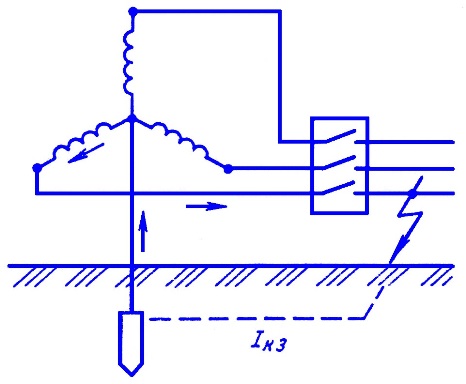Electrical networks with an effectively grounded neutral
An effectively earthed neutral is an earthed neutral of a three-phase supply network with a voltage above 1 kV, where the earth fault factor does not exceed 1.4.
What does it mean? The phase-to-earth voltage in the event of a short-circuit of one or two other phase conductors to the earth must be divided by the phase-to-earth voltage at that moment until the moment of earth fault, and the ratio must not be more than 1.4.
In other words, if a phase-earth fault occurs in a three-phase network with an isolated neutral, then the voltage between the remaining phases and the earth increases by about 1.73 times at the same time for a network with an effectively grounded neutral, this value does not exceed 1.4. …

This aspect is important when it comes to high-voltage networks, where, thanks to the effectively grounded neutral, there is no need to increase the amount of insulation in the equipment and in the networks themselves, that is, the production of networks and devices that will work in conditions with effective earthed neutral will always be cheaper.
The International Electrotechnical Commission recommends that extra-high and high-voltage networks with neutrals connected to earth or neutrals connected to earth through low resistance be classified as networks with an effectively earthed neutral. In particular, in Russia networks with a voltage of 110 kV are classified as networks with an effectively grounded neutral.

According to the rules for the technical operation of electrical installations of consumers, for networks with an effectively grounded neutral, the maximum resistance of the grounding device is adjusted to 0.5 Ohm, taking into account the natural grounding, and the artificial grounding device should not have a resistance of more than - greater than 1 Ohm. This applies to 1 kV electrical installations where the earth fault current exceeds 500 A.
This provision is dictated by the need to pass large currents through the device in the event of a short circuit to ground when the mains voltage is extra high or high, and the requirement to limit the voltage between the working phases and earth, in order to reduce in an emergency a dangerous overstep voltage and touch voltage, as well as compensation of potentials outside the substation.
It is necessary to evenly distribute the potentials on the territory of the substation, as well as exclude the appearance of step voltages at a distance from the substation, which is achieved by using potential equalization devices, which are a mandatory part of the grounding devices for effectively grounded neutrals.
Important nuances and requirements in the implementation of grounding devices for networks with effectively grounded neutrals create difficulties in their calculation and construction, make these structures material-intensive, especially if the soil has a high resistance, such as rocky, stony or sandy soil. Construction conditions are tight.
Of course, some so-called disadvantages are inherent in networks with effectively grounded neutral and are typical. Through the grounded neutral of the transformer, in the event of a short-circuit to earth, a significant short-circuit current occurs and this must be quickly eliminated by disconnection, thanks to the relay protection devices.
Mainly short-circuits to earth in 110 kV high-voltage networks are self-disconnecting and thanks to automatic closing devices power is restored. In order to be able to drain large currents, earthing loops are built, but they are expensive.
Single-phase short-circuit currents to ground, in the case of a large number of earthed transformer neutrals, can exceed the current of a three-phase circuit, and to eliminate this state of affairs, a mode of partial earthing of transformer neutrals is used, for this part of the transformers (110-220 kV) are not grounded, they neutrals are isolated by connecting to open disconnectors. Or they limit the transformer's short-circuit current to ground by grounding its neutral through a special resistance.
For each of the sections of the network, the minimum number of grounded neutrals is found through calculations. Based relay protection requirements to maintain earth fault currents at a certain level and to ensure the protection of the insulation of earthed neutrals from overvoltages, suitable earthing points of the power system are selected.
The fact is that transformers for 110 — 220 kV, traditionally for our manufacturers, are distinguished by reduced neutral insulation, for example, for 110 kV transformers with voltage regulation under load, the neutral insulation corresponds to 35 kV, since switching devices with insulation class are included on the neutral side 35 kV. The same applies to 220 kV transformers. The economic effect is significant.
Such transformers are designed to operate in networks with an effectively earthed neutral, and the voltage during a short circuit to earth from such networks will not exceed one-third of the line value, that is, 42 kV for 110 kV.
For overvoltage protection of grounded neutrals, for protection in no-load modes with partial phase connections or interruptions of transformers with isolated neutrals, short-time overvoltage protection devices-valves are used. The neutrals are protected by limiters for the maximum permissible extinguishing voltage of 50 kV.
